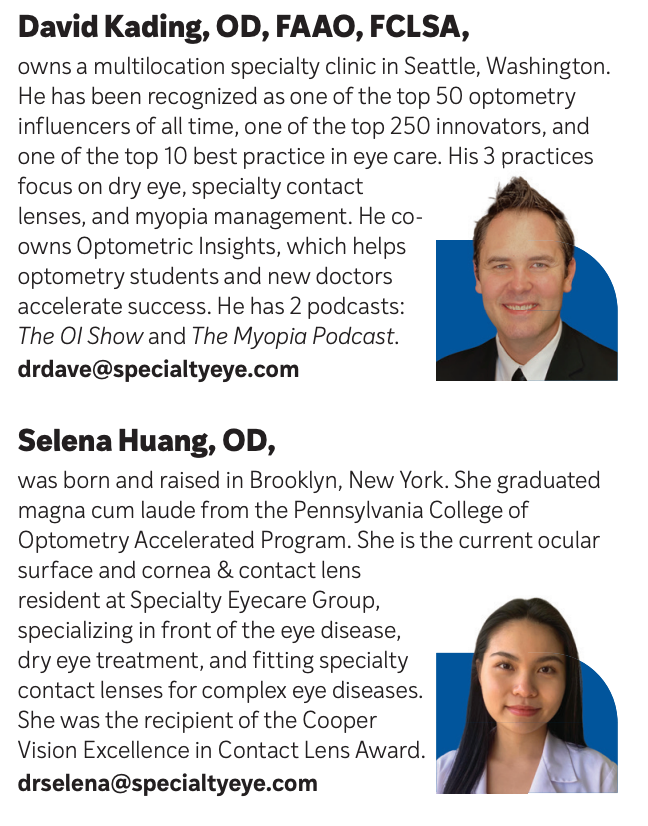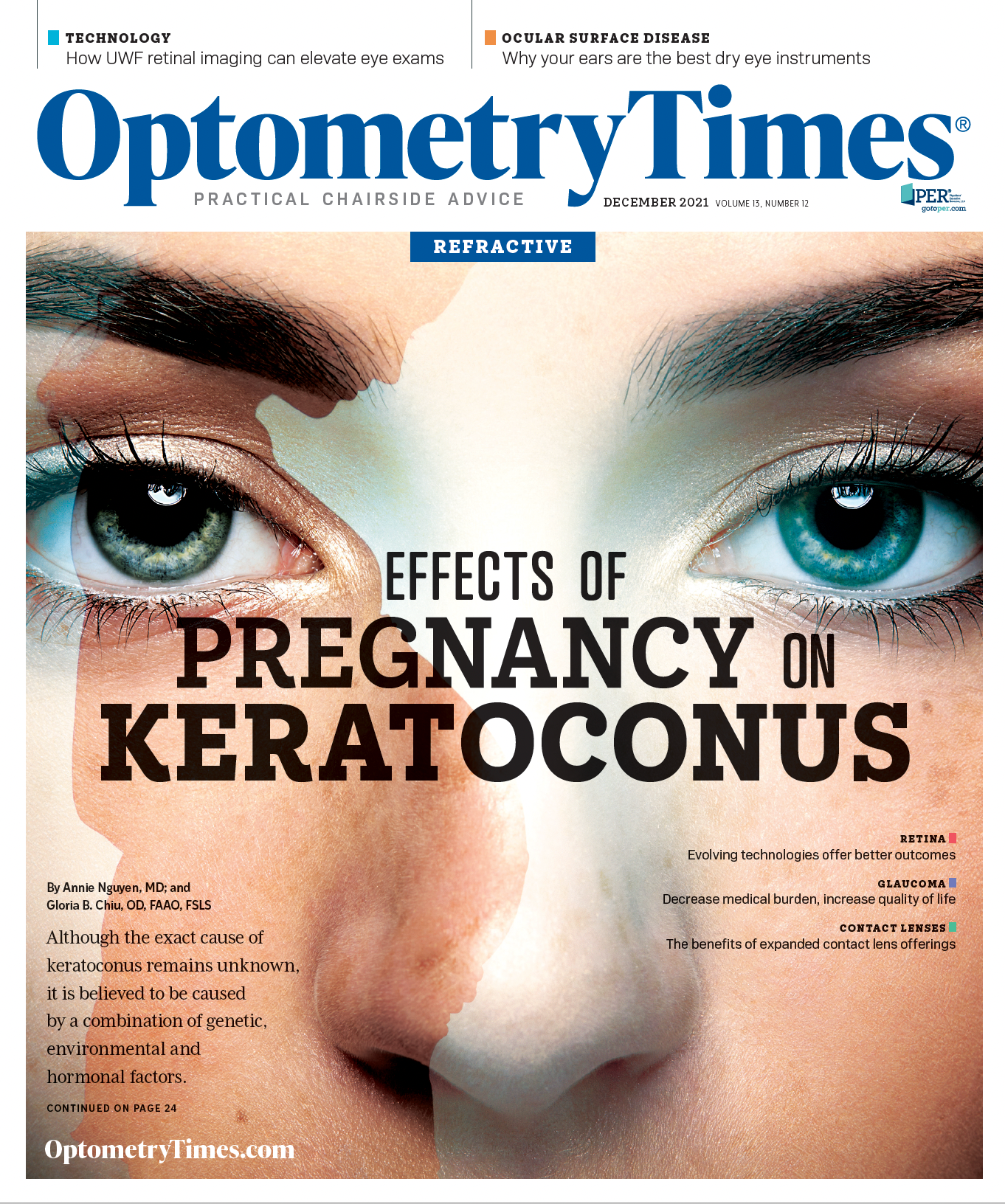Five ways to stand out with specialty contact lenses
Keep patients coming back to your practice by offering what competitors don’t have.


Doctors of optometry (ODs) who invest in providing specialty contact lenses are rewarded in a couple of ways.
First, the targeted care that patients receive tends to cement them as long-term, returning customers. This is because, in many cases, vision that had been deemed impossible to achieve becomes attainable.
Second, contact lens patients are more likely to develop a long-term relationship with the office that prescribes their specialty lenses due to an increase in visits for examinations and follow-up care. This translates into professional fulfillment for the practitioner and the office.
Related: Contact lens overwear leads to short-term, long-term consequences
Why specialty lenses are different
What makes specialty contact lenses so unique is the niche community they create. Designed for patients with ocular problems such as corneal conditions, specialty contact lenses can fully support desired treatment outcomes in cases where conventional contact lenses fall short.
Specialty contact lenses are an excellent choice when looking for a tailored fit for patients with regular and irregular corneas. They can improve visual comfort and visual function for patients who struggle to find contact lenses that fit snugly.
A myriad of specialty contact lenses exist that assist with a variety of corneal conditions. These include progressive myopia, hyperopia, high amounts of astigmatism, keratoconus, pellucid marginal degeneration, postcorneal surgery such as corneal transplant, post–laser-assisted in situ keratomileusis (LASIK) ectasia, corneal scars, dry eye, and general discomfort as a result of wearing contact lenses.
Related:Give toric ortho-k lenses a try
Similarly, there are a multitude of specialty contact lens options. These involve soft and rigid gas permeable (RGP) contact lenses (which include orthokeratology), piggyback contact lenses, scleral contact lenses, corneal-scleral lenses, mini scleral lenses, hybrid contact lenses, and prosthetic contact lenses.
Scleral lenses, RGP lenses, hybrid lenses, soft prosthetic contact lenses, and corneal molds are the 5 types used most often. Their track record of success supports the integration of all specialty lenses more broadly.
1. Scleral lenses
The diameter of scleral contact lenses is larger than that of conventional contact lenses, enabling their highly oxygen-permeable material to be fully utilized and increasing comfort.
Additionally, rather than sitting directly on the surface of the eye, scleral contact lenses rest on the sclera and tend to vault over the cornea; this leaves a tear reservoir between the lens and the cornea.
The sagittal height or central clearance is produced by a layer of tears, which is trapped under the lens to help reduce corneal aberrations, providing better vision outcomes for patients.
Scleral lenses should be filled with a nonpreserved saline solution to avoid any bubbles forming in the bowl of the lens. They should then be inserted onto the front surface of the eye.
Related: Use OCT to determine scleral lens clearance
The saline solution (with an occasional added drop of preservative artificial tear or autologous serum drops) acts as an ongoing reservoir for tear film, which keeps the front surface of the eyes hydrated and nourished for longer, improving dry eye symptoms and replacing the irregular cornea with a smooth surface. This often corrects visual problems caused by corneal irregularities.
Scleral lenses are tailored to each individual patient. Therefore, fitting them requires greater expertise, more chair time, and more frequent office visits than fitting conventional soft or smaller RGP lenses.
Imaging devices and automated measuring equipment are used with scleral lenses at the initial fit and subsequent follow-up visits to ensure a proper fit. These instruments are not typically required when fitting soft contact lenses.
The size of the scleral lens is determined by the complexity of the corneal condition. Often with keratoconus, due to the apical ectasia, the lens tends to dislodge more frequently and can move excessively with blinks, which causes ocular discomfort.
Because of this, we tend to fit the majority of our patients with keratoconus in scleral lenses.
More advanced and complex conditions such as moderate to severe keratoconus and ocular surface disease may necessitate a scleral lens with a larger than average diameter to ensure full coverage and to smooth the entire optical surface affected by the irregular cornea.
Related: Scleral lens wear and ocular surface disease
Keratoconic corneas tend to progress rapidly to the severe stage and typically do not respond to other therapies. Preserving ocular health along with optimum vision and comfort is of the utmost priority for patients with this condition.
The benefit of scleral lenses is that they do not dislodge with rapid eye movements, and particles such as dust and debris rarely make their way under the lens as long as the patient practices proper lid hygiene and lens maintenance.
2. Rigid gas permeable lenses
RGP lenses have been around for a long time and used to be the primary choice before hybrids and sclerals became available. RGP lenses provide sharper vision than soft and silicone hydrogel lenses due to superior optics, less lens flexure, and a reduction in deposit adherence.
GP lenses are excellent for providing support for patients with corneal toricity or spectacle blur and for those who experience poor vision with soft lenses.
Along with visual correction, RGP lenses offer orthokeratology correction, which reshapes the corneal surface to slow myopic progression.
They temporarily correct vision without the need for daytime contact lenses or glasses and are ideal both for children and individuals who play sports or whose jobs make it difficult to wear corrective lenses during the day.
Related: Total 30 contact lens coming in early 2022
3. Soft prosthetic contact lenses
Soft prosthetic contact lenses provide cosmetic, therapeutic, and psychological benefits for patients, particularly those who have scarred corneas, irregular irises, and disfigured eyes. These can result from trauma, glaucoma, infections, surgical complications, and congenital abnormalities.
Along with improvements in cosmetic appearance, the lenses can help block light and reduce visual disturbances that can cause pain, photophobia, double vision, and discomfort.
Several lens options are available, such as transparent tinting, standard opaque designs, and custom, hand-painted designs, depending on therapeutic and cosmetic requirements.
Related: How to fit scleral lenses with confidence and caution
Soft prosthetic contact lenses can help relieve emotional trauma while providing therapeutic care for patients with a multitude of ocular complications.
By fitting patients with custom-made soft prosthetic contact lenses, ODs can offer solutions that provide comfort to their patients.
4. Hybrid contact lenses
Hybrid contact lenses offer the longevity, durability, and clear vision of RGP lenses alongside the comfortable, wearable design of soft lenses. They achieve these results with a GP center surrounded by a soft outer lens material.
The soft skirt present around hybrid lenses bridges the junction between soft and GP material, allowing a more efficient tear pump mechanism and oxygen delivery throughout the day.
Ideal patient profiles include patients with regular corneal astigmatism and concerns with lens rotation or fluctuating vision in soft lenses along with irregular corneal profiles.
Hybrids are a great option and value for those practices who struggle to find a groove with other lens modalities.
Related: Podcast: Contact lens wear is a healthy option for kids
5. Corneal molds
When it comes to eyes with more nuances, poorly fit contact lenses increase the risk of complications such as corneal scarring. Should diagnostic and empirical fits fail in a more complicated case, eye molded prosthetics can create custom fit scleral lenses.
They do so by gathering impressions of the corneas, a process that takes no longer than 2 minutes, and using these to design specialized lenses matching the exact contours of each eye. The lenses that result from this process provide great stability and comfort to the wearer.
The large area of coverage and durability of corneal molds may result in improved comfort and vision that is more stable than traditional, smaller GP or hybrid lenses.
These specialty scleral lenses can be designed to accommodate corneal steepness and irregularities found in corneal ectatic conditions.
Related: Multifocal lenses for presbyopia in eyes with previous corneal surgery
Conclusion
Specialty contact lenses have made a huge impact in the world of optometry. Understanding and sharing their benefits is a journey that many ODs have yet to fully explore.
However, when time is invested into troubleshooting for optimum vision, fit, and quality of care, patient satisfaction soars. In fact, many specialty contact lens wearers are so pleased with their custom lenses, they are unwilling to return to alternative modalities.
As a result, ODs who offer them enjoy more loyal patients who are less likely to shop around elsewhere.
See more contact lens coverage

Newsletter
Want more insights like this? Subscribe to Optometry Times and get clinical pearls and practice tips delivered straight to your inbox.